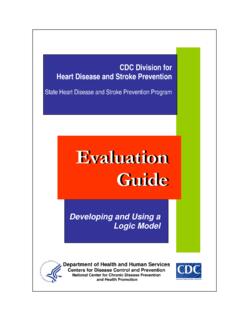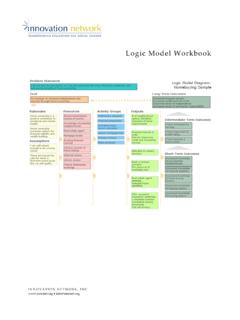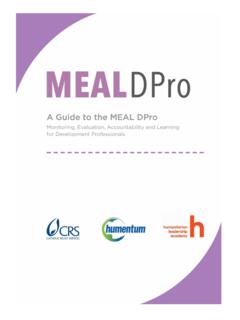Transcription of Program theory and logic models - EvaluATOD
1 Program theory and logic models Wilder Research, August 2009 1 Wilder Research Program theory and logic models Evaluation resources from Wilder Research All human service programs are designed to make a difference in the lives of people or to improve our society. But how? This resource guide discusses Program theory and logic models . Program theory explains why a Program is expected to work and a logic model illustrates a Program theory . At the end of this section, there are a number of examples and worksheets that can help you develop a Program theory and logic model . When you set out to design or redesign a Program , you are choosing among many options. For example, if you want to prevent alcohol use among teens, how do you decide which activities to include? Since you can t do everything that might help, which services are most important?
2 Which ones need to be combined with other services in order to be most effective? These questions all get at your underlying Program theory . A Program theory explains how and why a Program is supposed to work. Spelling out that theory can be one of the most important things you do for the success of your Program . It provides a logical and reasonable description of why the things you do your Program activities should lead to the intended results or benefits (Appendix A). Clarity and plain language are essential. Can you explain it to your neighbor, or to your third cousin at a family reunion? Don t assume that your funders or staff members are any more sophisticated in their need for a clear description. Not only will a clear Program theory help others see the sense of your Program , it will help you make sure you are actually providing the package of services that have the best possible chance of helping participants.
3 And when it comes to evaluating your results, a clear Program theory makes it much easier to choose the most appropriate outcomes (results) to measure. Some ATOD prevention programs sound promising, but do not result in the desired changes for participants. Of course, this could be because a good theory is not being carried out well, but in some cases, the problem is the theory itself. Make sure that your theory not only looks clear and makes sense on paper, but that it is based on good underlying evidence about what makes programs successful and how people really change. To avoid a shaky theory that leads to disappointing results, go deeper than common assumptions about how certain activities lead to outcomes. Instead, consider the available theories and research evidence that support these connections. In this way, you can be more confident in the underlying strength of your service delivery model .
4 If you re not sure what the current research is showing, take some time to find out. Talk with colleagues in the field about what evidence they ve seen lately. Look online or in a Program theory and logic models Wilder Research, August 2009 2 library for recent information. Review material presented at the best conferences in your field to see what the latest research and evaluation studies are showing. The if-then connection Program theories can often be captured in a series of if-then statements IF something is done with or for the Program participants, THEN something should change. For example, a Program to reduce aggression based on social learning theory could have an underlying theory like this: IF Program mentors model strategies for avoiding alcohol, tobacco, or other drugs in social situations and provide opportunities for participants to practice these strategies, THEN participants will develop skills in avoiding using these substances.
5 A Program theory should also spell out why you expect the changes to happen. Between the if and the then, there should be some solid evidence or some well-established connection supporting the idea that your service package will accomplish your Program goals. A good Program theory also reflects the fact that change happens in stages. For example, many programs have a goal of changing some type of behavior. However, there are usually several things that have to happen first. People usually change their behavior after first learning some new information, developing a new skill, or changing their attitude about something. Sample outline for a Program theory IF a certain set of resources (such as staff, equipment, materials) are available, THEN the Program can provide a certain set of activities or services to participants. IF participants receive these services, THEN they experience specific changes in their knowledge, attitudes, or skills.
6 IF individuals change their knowledge, attitudes, or skills, THEN they will change their behavior and usual practice. IF enough participants change their behavior and practice, THEN the Program may have a broader impact on the families or friends of participants or on the community as a whole. Program theory and logic models Wilder Research, August 2009 3 For example, a school-based ATOD prevention Program could have the following theory : Trained teachers provide alcohol prevention training to youth. Youth gain knowledge of alcohol avoidance strategies. Youth practice alcohol avoidance strategies. Youth reduce alcohol initiation and use. As a result of the reduced alcohol use of individual youth, alcohol problems in schools will decline. Program theory and logic models Wilder Research, August 2009 4 Here s how to start To develop a Program theory , select one of your activities and answer the following three questions (Appendix B): IF the activity is provided, THEN what realistically should be the result for participants?
7 WHY do you believe the activity will lead to this result? (In other words, what is your assumption about how this kind of change occurs? Are you drawing from an established theory used by others?) What evidence do you have that the activity will lead to this result (such as previous results from your own or other programs , published research, or consistent feedback from participants)? Repeat the same three questions for each activity or service that you provide. Don t worry; you don t need to develop a theory for everything! Administrative tasks, such as training staff or doing paperwork, typically are not included in a Program theory . These activities, while a necessary part of running a Program , are usually not the important services that produce change in participants. Focus on the main services you provide the ones you most count on to promote positive results.
8 How does a theory differ from a logic model ? A Program theory is similar in concept to logic models , which have become increasingly popular in human services programs over the past several years. In simple terms, a logic model is a picture of your theory a drawing that shows how one thing leads to the next, like a flow chart. A logic model uses short phrases to represent things that you explain in more detail in the Program theory . Another key difference is that, while a logic model can just use an arrow to show that one thing leads to the next, your Program theory needs to lay out the evidence to show why you believe one thing will lead to the next. A logic model is one commonly-used tool for illustrating an underlying Program theory . Most often, it is presented in the form of a flow chart that illustrates the linkages between Program components and outcomes.
9 Program theory and logic models Wilder Research, August 2009 5 The following components are usually included: Inputs: any resources or materials used by the Program to provide its activities ( , money, staff, volunteers, facilities, equipment, supplies) Activities: any services or treatments provided by the Program Outputs: amount of activity provided, described in quantifiable terms ( , number of classes taught, number of people served, amount of educational materials distributed, number of hours of service delivered) Outcomes: any characteristics of the participants that, according to the Program theory , are expected to change as a result of the participant s receiving services Sample logic models are attached at the end of the section (Appendix C & D). The model is read as follows: The first column lists the resources needed by the Program to provide services.
10 The second column lists the actual activities/services provided by the Program . The third column lists the quantifiable products or outputs of the services provided. Beginning with the fourth column, the model illustrates the outcomes of the Program for participants. The number of outcome columns varies depending on the underlying logic . One frequent approach is to have the following three columns, but there may be more or less: The fourth column usually describes the immediate impacts or results of these activities. They should be read as if the activities are provided, then these outcomes should result. Immediate impacts typically refer to changes in knowledge, skills, or awareness, as these types of changes typically precede changes in behaviors or practices. The fifth column typically describes intermediate outcomes. They should be read as if the immediate outcomes occur, then the intermediate outcomes should result.





